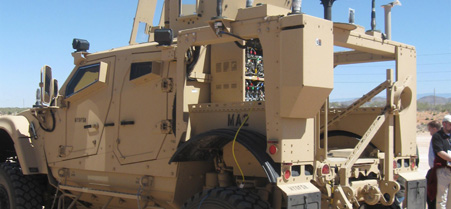Army impressed by initial test of next generation radios
A central part of a plan to modernize brigades, radios will link units so they can transmit broadband data, including imagery.
 The Army is testing new radios mounted in MRAPs that can send data-heavy files such as imagery.
The Army is testing new radios mounted in MRAPs that can send data-heavy files such as imagery.
WHITE SANDS MISSILE RANGE, N.M. -- Army officials said on Thursday they have been impressed by early tests at this sprawling 3,200-square-mile base of an advanced radio that is designed to send huge files of maps and images to soldiers in the field and improve transmissions in mountainous areas such as Afghanistan.
The next generation devices, called ground mobile radios, are wideband versions of the Joint Tactical Radio System under development since 1996 and have sent data as far as 19.5 miles during tests this week, said Col. John Wendell, program manager for the Army's infantry brigade combat team integration project. The radios are a central part of the Army's plan to modernize its brigades and will link units so that they can communicate not only by voice but transmit broadband data, including imagery.
The Army plans to continue testing the new radios, developed by Boeing Co., through June and expects its range to increase.
In addition, the latest version exceeded its required throughput of 2 megabytes per second, a generational leap from existing radios, said Maj. David Jimenez, a product manager for the ground mobile radio at the JTRS program office in San Diego. He attributed the increased performance to improvements in the software, which was not fully developed when the radios were tested in 2009.
The type of radio used to transmit data from unmanned ground sensors such as cameras and robots has also performed better, making connections over a distance of more than six miles, Wendell said.
In March, J. Michael Gilmore, the Defense Department's director of operational test and evaluation, told lawmakers at a House Armed Services Committee hearing that the radios had suffered a slip in development testing last year because of hardware and software problems, which resulted in low throughput. JTRS has been in development since 1996.
Gilmore also criticized the mobile radios for failing to meet security standards required by the National Security Agency. Jimenez said he believes those problems have been resolved.
In 2009, the Army tested the JTRS radios in a 38-square-mile area here. This year the tests involve units across more than 350 square miles, similar to a setting in which the 1st Armored Division's 3rd Infantry Brigade Combat Team will operate when it is deployed to Afghanistan, said Jerry Tyree, director of operations for the integration project.
The terrain and scenarios will mimic operations in Afghanistan, including mountainous areas that can block radio signals and in villages.
The test brigade will field the ground radios and network integration kits, which include a computer system running on 18 million lines of code. The system manages the radio network mounted in mine resistant ambush protected vehicles (MRAPs).
MRAPs do not carry JTRS radios, so project officials set up a manufacturing facility here, installing the mobile radios and integration kits in 12 of the vehicles that will be used in tests.
The Space and Naval Warfare Systems Center in Charleston, S.C., installs a standard suite of radios in MRAPs, and Tyree said it would be logical for the facility to install the new radios and kits.
Jimenez commanded an artillery battery in Afghanistan and oversaw platoons scattered for miles across a mountainous landscape that made communications difficult or impossible using terrestrial radios. But he said he is optimistic that the latest version of the mobile radios will work better in rugged terrain. Still, Jimenez said he will not hesitate to flunk the new radio if it does not perform well during tests.
Maj. Gen Keith Walker, director of the Army's Future Force Integration Directorate, which will test the radios, said if they do not perform to specification, the Army will not buy them.






